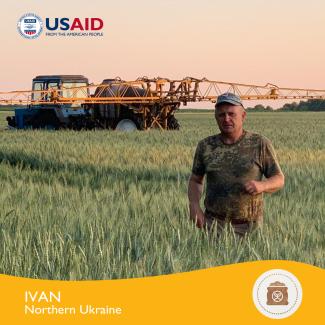Ivan is a hardworking man who founded a farm in the north of Ukraine in 1992. Since then, he has worked the soil, cultivating grains and oilseeds such as wheat, sunflower, and soy. Over the years, Ivan managed to acquire essential farming machinery, granaries for storing grain, and established beneficial partnerships with suppliers and customers for his produce.
But February 24, 2022 changed everything. Ivan’s village is just two kilometers from Ukraine’s border with Russia, and his fields sit perilously close to it.
“The war has brought many troubles,” he explains.
“We are on the border with the aggressor, under fire every day. It’s tough. There are times when you drive a tractor into the field, and warning shots are fired near you. You turn around and head back home. The next day, I try again, and they keep an eye on us but don’t bother us. That’s how we work here.”
Before the war, Ivan was cultivating 118 hectares of land. Now, parts of his fields are mined, and approximately 25 hectares remain unsown. Despite everything, Ivan continues to work, sowing the fields and harvesting crops when it’s possible to get to them.
He is one of the over 8,200 farmers who received assistance from the USAID Agriculture Growing Rural Opportunities Activity (AGRO) to complete their 2023 spring sowing season. Ivan received one ton of ammonium sulfate fertilizer to nourish his grain crops.
Ivan says that the aid has been critical for his farm, and his survival. In addition to tending his crops, Ivan must also manage destruction caused by Russia’s war, and repair the damaged buildings and machinery, even his own home.
“There are many damaged warehouses and houses. There are holes in the roof, in the house... Sometimes shards fly right into the yard. The shed is damaged now, the roof shattered by fragments, we are patching it up... We put a sofa in the basement, we run there when we need to. But we try to get to the fields early and work because there is less shelling in the fields than in the village.”
The grain in Ivan’s stores and the crops in the fields reassure Ivan that his farm has a future after Russia’s war, and that it will continue to provide income for his workers, and put food on their tables. That’s why Ivan continues to work, for as long as he can, despite Russia’s continued shelling.
“The main thing now is to survive. Somehow sow, somehow mow, and manage to sell at least part of it,” he professes.
Providing mineral fertilizers and other critically important resources for agricultural producers is part of USAID AGRO’s larger effort for the Agriculture Resilience Initiative-Ukraine (AGRI-Ukraine). In 2022, USAID launched this initiative in response to the global food crisis, which is deepening due to the war instigated by Russia. In spring 2023, over 8,200 Ukrainian agricultural producers received more than 6,300 tons of fertilizers from USAID, as well as seeds to sow sunflowers on over 48,300 hectares and corn on over 15,000 hectares. Another 12,000 tons of fertilizers were provided to farmers in time for this year’s autumn sowing season. These measures contribute to strengthening the entire agricultural sector and help preserve its potential as one of the main drivers of Ukraine’s economy.

